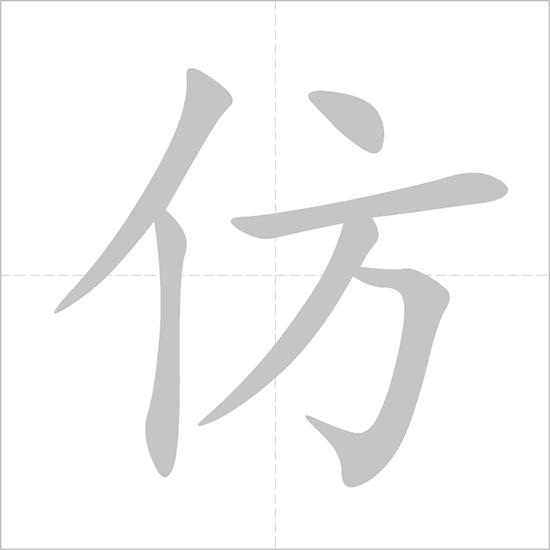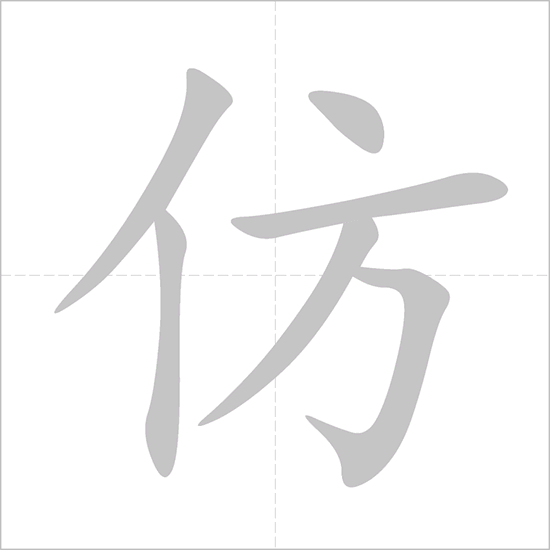Showing Results in:
- ENGLISH
- SEE TRADITIONAL
- SEE CANTONESE
-
Tone
Phonetics: Tone colors (āáǎàa):
Learn more about 模仿
- Written Chinese
- Dictionary
- "模仿" Character Details
| Pinyin | Yale | Jyutping | English Definition for Chinese Text |
|---|---|---|---|
| mou4 fong2 | mou4 fong2 | to imitate / to copy / to emulate / to mimic / model |
| Traditional Chinese | Pinyin | Yale | Jyutping | English Definition for Chinese Text |
|---|---|---|---|---|
| mou4 | mou4 | to imitate / model / norm / pattern | ||
| fong2 | fong2 | to imitate / to copy |
How do you remember 模仿 ?
Post your photos, example sentences and daily homework here to share with the Chinese learning community.
How to use 模仿 in a Sentence
Overcome with admiration, he could not but imitate them.
A sheet of metal was shaken to simulate the noise of thunder.
- 口 kǒu
- 頭 tóu
- 傳 chuán
- 承 chéng
- 還 hái
- 包 bāo
- 括 kuò
- 習 xí
- 俗 sú
- 方 fāng
- 面 miàn
- 的 de
- 示 shì
- 範 fàn
- 和 hé
- 模 mó
- 仿 fǎng
- . .
Oral transmission also includes passage by customary demonstration and imitation.
- 青 qīng
- 少 shǎo
- 年 nián
- 非 fēi
- 常 cháng
- 盲 máng
- 從 cóng
- , ,
- 經 jīng
- 常 cháng
- 模 mó
- 仿 fǎng
- 他 tā
- 們 men
- 的 de
- 偶 ǒu
- 像 xiàng
- 的 de
- 行 xíng
- 為 wéi
- 。 。
Teenagers are very sequacious and they often emulate the behavior of their idols.
- 人 rén
- 們 men
- 發 fā
- 現 xiàn
- 兒 ér
- 童 tóng
- 會 huì
- 模 mó
- 仿 fǎng
- 他 tā
- 們 men
- 所 suǒ
- 崇 chóng
- 拜 bài
- 或 huò
- 有 yǒu
- 共 gòng
- 鳴 míng
- 感 gǎn
- 的 de
- 人 rén
- 。 。
Children can be seen to copy the behaviour of others whom they admire or identify with.
- 他 tā
- 能 néng
- 模 mó
- 仿 fǎng
- 大 dà
- 多 duō
- 數 shù
- 自 zì
- 己 jǐ
- 崇 chóng
- 拜 bài
- 的 de
- 偶 ǒu
- 像 xiàng
- 的 de
- 講 jiǎng
- 話 huà
- 和 hé
- 寫 xiě
- 作 zuò
- 風 fēng
- 格 gé
- 。 。
He could imitate in speech or writing most of those he admired.
- 神 shén
- 界 jiè
- 是 shì
- 擬 nǐ
- 人 rén
- 化 huà
- 的 de
- , ,
- 是 shì
- 模 mó
- 仿 fǎng
- 我 wǒ
- 們 men
- 人 rén
- 類 lèi
- 世 shì
- 界 jiè
- 的 de
- 一 yī
- 個 gè
- 投 tóu
- 影 yǐng
- 。 。
The world of the gods is anthropomorphic, an imitative projection of ours.
- 這 zhè
- 證 zhèng
- 明 míng
- 認 rèn
- 為 wéi
- 兒 ér
- 童 tóng
- 只 zhǐ
- 會 huì
- 單 dān
- 純 chún
- 地 dì
- 模 mó
- 仿 fǎng
- 的 de
- 理 lǐ
- 論 lùn
- 是 shì
- 站 zhàn
- 不 bù
- 住 zhù
- 腳 jiǎo
- 的 de
- . .
This disproves the theory that children are purely imitative.
- 這 zhè
- 個 gè
- 節 jié
- 目 mù
- 值 zhí
- 得 dé
- 一 yī
- 看 kàn
- , ,
- 因 yīn
- 為 wéi
- 有 yǒu
- 對 duì
- 柯 kē
- 林 lín
- 斯 sī
- 姐 jiě
- 妹 mèi
- 的 de
- 滑 huá
- 稽 jī
- 創 chuàng
- 意 yì
- 模 mó
- 仿 fǎng
- 。 。
The programme was worth watching for an inspired takeoff of the Collins sisters.
- 聲 shēng
- 音 yīn
- 渾 hún
- 厚 hòu
- 、 、
- 威 wēi
- 嚴 yán
- , ,
- 儼 yǎn
- 然 rán
- 是 shì
- 哈 hā
- 佛 fó
- 出 chū
- 身 shēn
- 的 de
- 氣 qì
- 派 pài
- , ,
- 就 jiù
- 跟 gēn
- 無 wú
- 線 xiàn
- 電 diàn
- 里 lǐ
- 所 suǒ
- 有 yǒu
- 的 de
- 滑 huá
- 稽 jī
- 演 yǎn
- 員 yuán
- 叫 jiào
- 人 rén
- 已 yǐ
- 經 jīng
- 聽 tīng
- 膩 nì
- 的 de
- 模 mó
- 仿 fǎng
- 完 wán
- 全 quán
- 一 yī
- 樣 yàng
- . .
The voice was rich, lordly, Harvardish, like all the boring radio comedians'imitations.
- Chinese Characters with 1 Stroke
- Chinese Characters with 2 Strokes
- Chinese Characters with 3 Strokes
- Chinese Characters with 4 Strokes
- Chinese Characters with 5 Strokes
- Chinese Characters with 6 Strokes
- Chinese Characters with 7 Strokes
- Chinese Characters with 8 Strokes
- Chinese Characters with 9 Strokes
- Chinese Characters with 10 Strokes
- Chinese Characters with 11 Strokes
- Chinese Characters with 12 Strokes
- Chinese Characters with 13 Strokes
- Chinese Characters with 14 Strokes
- Chinese Characters with 15 Strokes
- Chinese Characters with 16 Strokes
- Chinese Characters with 17 Strokes
- Chinese Characters with 18 Strokes
- Chinese Characters with 19 Strokes
- Chinese Characters with 20 Strokes
- Chinese Characters with 21 Strokes
- Chinese Characters with 22 Strokes
- Chinese Characters with 23 Strokes
- Chinese Characters with 24 Strokes
- Chinese Characters with 25 Strokes
- Chinese Characters with 26 Strokes
- Chinese Characters with 27 Strokes



